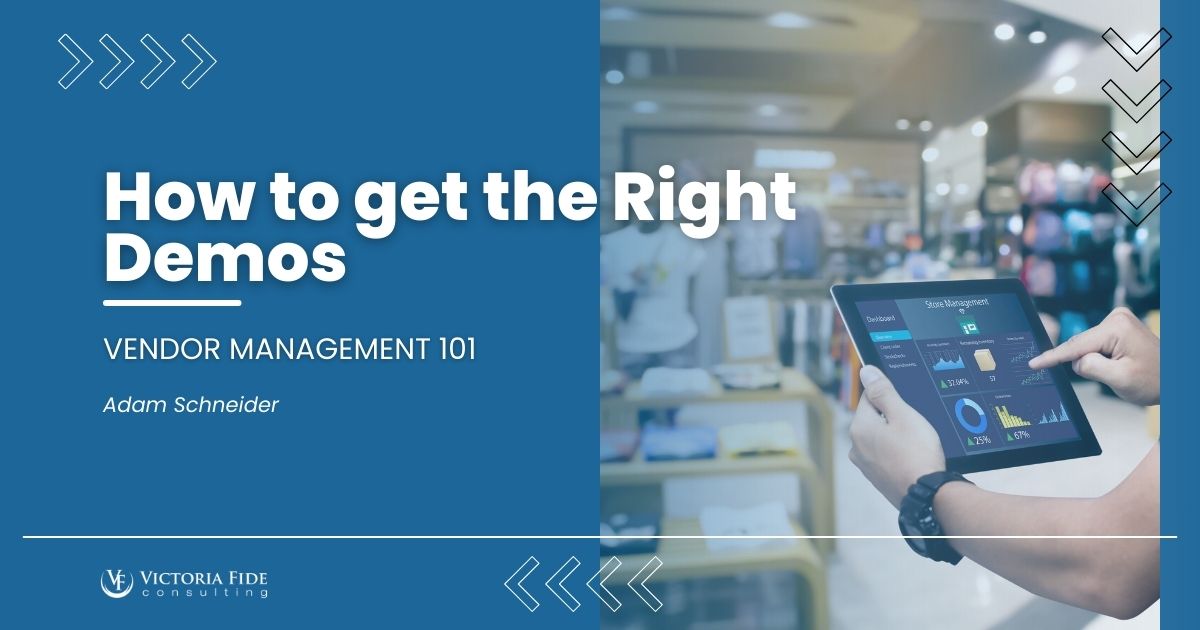
Choosing the right business solution is a pivotal decision that will impact the future efficiency and success of your business. To make an informed choice, it’s essential to request and evaluate demos that align with your organization’s specific needs. Unfortunately, obtaining high quality, relevant demos is easier said than done.
This article will guide you through the process of getting the right demos, from identifying key requirements and business processes to developing effective scripts and ensuring vendor accountability.
Table of Contents
How to Get the Right Demos: Why It Matters
Obtaining high-quality vendor demos that meet your organization’s specific needs can be a daunting task. Vendors often showcase general features or idealized workflows instead of focusing on your business priorities. This makes it hard to assess whether the system fits your requirements or can scale with your operations long-term. Even if the vendor claims it will work, it’s tough to tell what’s fully functional versus what might require costly customization later.
Additionally, some demos can be incredibly lengthy, spanning the length of multiple days and including information that may not even be relevant to your business. After reviewing multiple demos with enormous amounts of information, this can make it difficult to determine which solution would be the best fit for your needs.
Without a clear, focused, and applicable demonstration, organizations risk wasting valuable time and resources, and may ultimately make decisions based on surface-level impressions rather than substantive evaluation. In order to get the right demos from vendors and ultimately make the best decision for your organization, keep in mind the following four core principles.
1. Start with Clear Requirements: The Foundation of the Demo Process
Before diving into demos, define clear and comprehensive business requirements. This includes understanding both your functional and technical needs. Engage key stakeholders across departments to capture their expectations and pain points. Consider the following when defining requirements for a new Enterprise Resource Planning (ERP) system:
- Business Processes: Identify which processes will be managed by the ERP, including inventory management, order processing, finance, HR, and customer service. Prioritize the processes that are most critical to your operations.
- Technical Requirements: Understand the technical needs, such as cloud vs. on-premise deployment, scalability, integration with other systems, and security.
- Compliance and Reporting: Be clear on regulatory requirements, as well as any industry-specific compliance considerations your ERP must meet.
By having well-documented and prioritized requirements, you can ensure that the ERP demos you request will be tailored to your actual needs.

Don’t leave your solution selection to chance. Trust our experts to guide you through the complexities of vendor evaluation and needs assessment.
2. Understand Your Business Processes and How the ERP Can Support Them
The right ERP system should help streamline and improve your business processes, not force you to change them unnecessarily. When setting up demos, make sure that:
- Core Business Processes are Represented: Your ERP vendor should be able to demonstrate how their system handles your key business functions, from procurement to production to customer relationship management (CRM).
- Flexibility for Customization: Understand whether the ERP system can adapt to your business’s unique workflows. Does the vendor offer configuration options to modify the system as your processes evolve?
By understanding how the ERP system will integrate with and support your current processes, you can identify potential areas for improvement or inefficiency.
3. Develop Detailed Demo Scripts: Ensure Demos Are Tailored to Your Needs
A generic demo is not enough to make a fully informed decision. Instead, work with your team to create customized demo scripts that reflect your requirements. When developing scripts:
- Create Specific Scenarios: Write detailed, real-world scenarios based on your company’s daily operations. For example, if inventory management is a critical function, include scenarios around stock levels, purchase orders, and reordering. This will allow you to evaluate how the ERP supports each step in the process and identify potential gaps or issues.
- Include Various Roles: Ensure that the demo addresses different user roles, such as finance managers, warehouse workers, and sales teams. This way, you’ll get a comprehensive view of how the system performs across departments.
- Highlight Reporting and Analytics: Make sure to incorporate reporting needs into your scripts. Evaluate the ERP’s ability to provide actionable insights, dashboards, and ad-hoc reporting.
- Request Real-Time Processing: Ask the vendor to demonstrate the system’s real-time capabilities, such as how quickly transactions are processed, or updates are reflected across modules.
Having a detailed script ensures that your demo is focused on the features that matter most to your business and will allow you to make an apples-to-apples comparison of vendors.
4. Hold Vendors Accountable: Ensure a Transparent and Effective Evaluation
Vendor accountability is key to ensuring you get the right ERP system for your business. You want a vendor who will provide the right level of support, customization, and ongoing service. Here’s how to hold them accountable:
- Transparency in Capabilities: Ask the vendor to explicitly demonstrate how their ERP meets your requirements and request specific examples that have been outlined in the demo scripts. They should be able to explain how the system will function in real-world situations, not just show a polished, idealized version.
- Proof of Performance: Request references or case studies from companies in your industry that are using the ERP system. Ask the vendor to provide success stories that are relevant to your business size and needs.
- Evaluation Criteria: Set up a scoring system to evaluate vendors objectively based on the demo. This will help keep the selection process fair and focused on your specific needs.
- Post-Demo Follow-Up: After the demo, allow your team time to review the system’s performance against the criteria and business processes you’ve outlined. Hold follow-up meetings with vendors to clarify any concerns and ensure that they can meet your requirements.
Solution Selection Guidance: Make the Right Choice for Your Business
The process of selecting a business solution such as an ERP system doesn’t begin or end with watching a demo. It requires thorough preparation, a clear understanding of your business needs, and a thoughtful approach to evaluating vendor capabilities. By focusing on clear requirements, developing specific demo scripts, and holding vendors accountable, you can make a more informed decision and ultimately choose the ERP system that will support your business growth for years to come.
If your business needs help finding the right solution, Victoria Fide Consulting is here to simplify the process. Our Solution Selection Guidance streamlines vendor management to match you with vendors that fit your technical and cultural needs. We help define and finalize requirements, then connect them to vendors. With our tech expertise and deep understanding of client needs, we offer the perfect third-party perspective to evaluate demos and help you choose the best solution for your needs. Contact us today to learn more!

About the Author
Adam Schneider is a business transformation change agent specializing in manufacturing and supply chain. For Adam, the most rewarding parts of the client journey are working on creative solutions to complex business problems and enabling the people he works with to implement and lead change for a business. Adam does this by establishing a great rapport with the team and relying on his background in engineering for problem solving.
